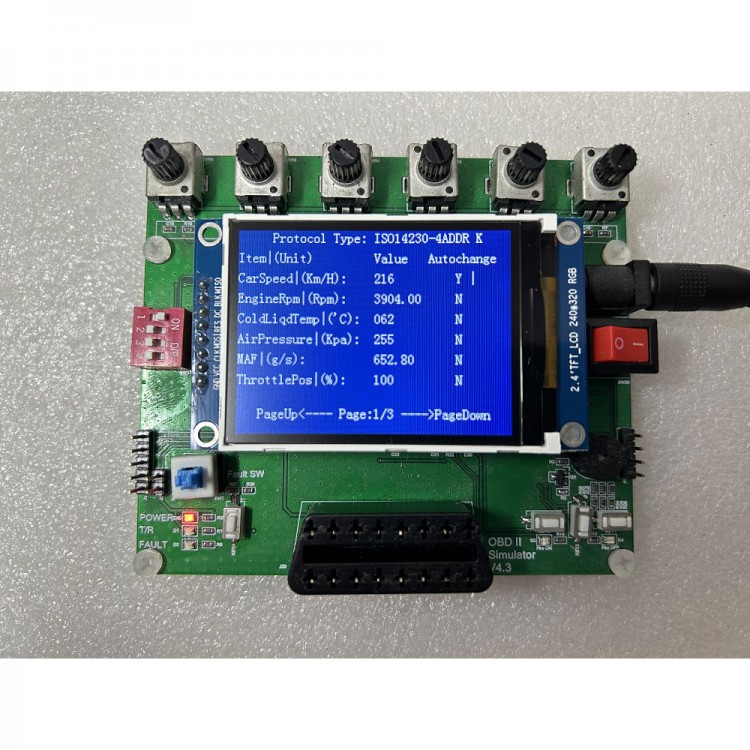
| Quantity | 3+ units | 10+ units | 30+ units | 50+ units | More |
|---|---|---|---|---|---|
| Price /Unit | $134.00 | $131.26 | $127.16 | $121.69 | Contact US |
 USBCAN-OBD Portable Automotive Decoding Single Channel USB CAN Analyzer Dedicated for Automotive OBDII
$41.13
USBCAN-OBD Portable Automotive Decoding Single Channel USB CAN Analyzer Dedicated for Automotive OBDII
$41.13
 AERMOTOR EM415PRO 6-42V Car Short Open Circuit Detector Automotive Circuit Tester without Oxford Bag
$15.41
AERMOTOR EM415PRO 6-42V Car Short Open Circuit Detector Automotive Circuit Tester without Oxford Bag
$15.41
 MAYILON MY6770 Automotive Coating Thickness Gauge Paint Thickness Gauge Fe/NFe 0-1300µm Tester
$39.11
MAYILON MY6770 Automotive Coating Thickness Gauge Paint Thickness Gauge Fe/NFe 0-1300µm Tester
$39.11
OBD II Simulator ECU Simulator 2.4" Screen (7 Conventional Protocols & Values Change Automatically)
Advantages:
- It has a 2.4" 320*240 screen, provides real-time display of 10 basic parameters and supports button adjustment.
- It supports real-time display of fault codes and VINs. It can be dynamically modified, and supports up to 30 fault codes at the same time.
- It supports to open the debugging information display of OBD protocol interaction through commands, which is convenient for familiarity with the OBD command protocol.
- Software is provided for host computer operation (host computer software is implemented by qt, and the source code is not open source), making it easy to operate and display more than 150 parameters.
- The host computer software supports the log file function, which can record all the command interaction processes with the OBDII simulator.
Description:
The vehicle OBD II simulator is a simulator device that simulates the vehicle OBD bus protocol. It has dynamic simulation and real-time LCD display of the main parameter content. It is very convenient and practical.
The simulator supports the simulation of multiple protocol interface standards, and can be flexibly switched between various protocols through DIP switches. It provides a real-time simulation of more than 150 data, which is close to the real car environment, allowing you to save fuel. In addition, it supports modifying and saving VINs, as well as simulating three fault codes.
A 220V to 12V power adapter is provided to make the simulated environment more realistic to the real car environment.
Features:
- The board contains STM32F103CBT6 chip (128KB Flash and 20KB RAM) with LQFP48 pins. Rich interface and powerful and fast operation.
- A standard 16pin OBD connector is onboard.
- There are 6 adjustable movable potentiometers on board. The potentiometers can dynamically adjust a variety of parameters. They support the flipping of analog parameters, and the 6 inputs correspond to the 6 parameters of the current interface.
- The onboard LCD screen makes it convenient for real-time data display.
- The on-board DIP switches make it easy for users to switch protocols.
- There are 3 LED indicators and 1 self-locking switch input on board, which is convenient for simulating and prompting various fault codes.
- The on-board buzzer facilitates the output of the prompt tone.
- There are 3 user-defined buttons on board, of which the left and right buttons are used to turn pages on the interface. The middle button is not functional, and this button may be used to simulate ignition/flameout in the future.
7 Protocols Supported by the OBD Simulators are as Follows:
1. ISO14230--4ADDR K
2. ISO14230--4HL K
3. ISO9141--2ADDR K
4. ISO15765--4STD--500K CAN
5. ISO15765--4EXT--500K CAN
6. ISO15765--4STD--250K CAN
7. ISO15765--4EXT--250K CAN
Package Included:
- 1 x OBD simulator
- 1 x 12V power adapter
- 1 x PL2303HX chip-based serial cable for debugging
- 1 x Vehicle charging cable
Packaging Details:
- Weight: 0.45kg
Attention:
- This product is only for vehicle electronics engineers to learn OBD technology, or for companies to develop HUD or OBD-like products. Please do not use it for other purposes.
- Our OBD simulator simulates the OBD data inside a car. It is a passive unit, and it needs to be commanded to return various parameter data. If you want to buy an OBD simulator to simulate your car's data, you first need to understand your car's OBD protocol format! You can buy our product if your car's OBD protocol is supported by our OBD simulator.